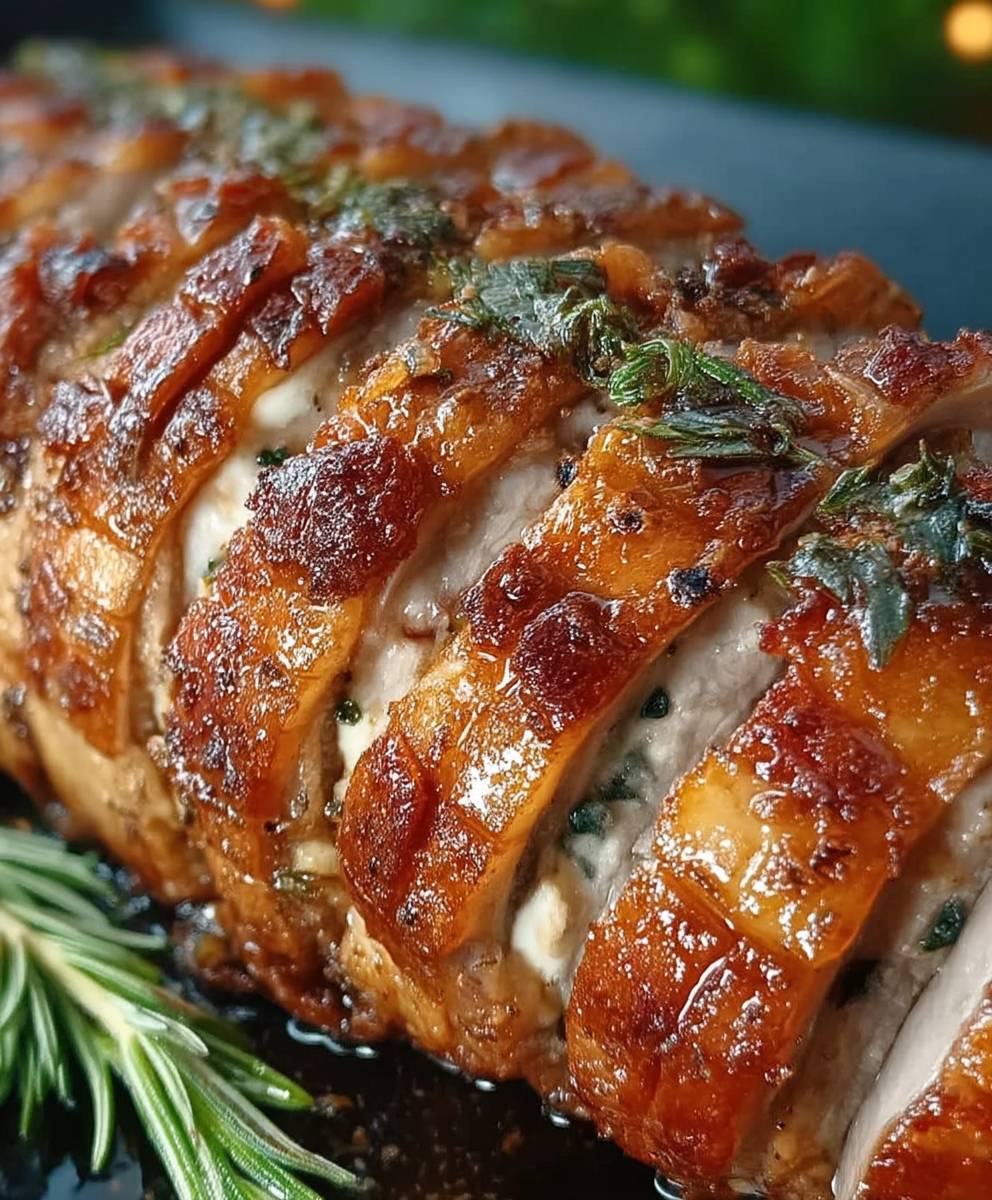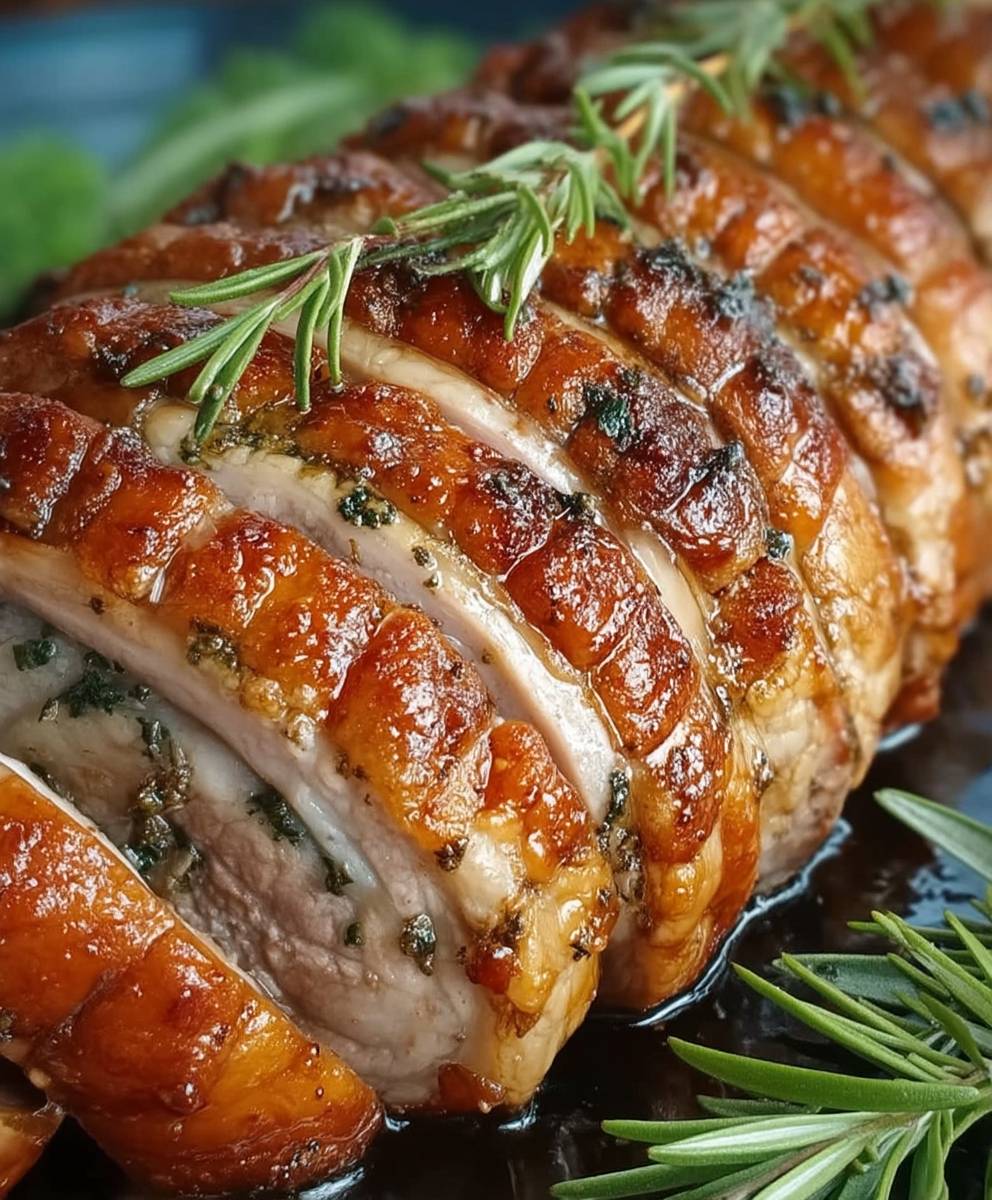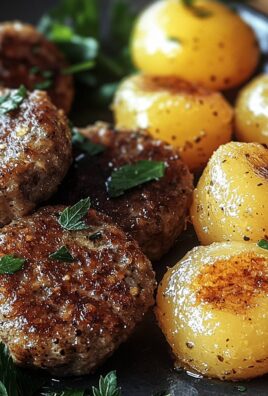Italian Porchetta: Prepare to embark on a culinary journey to the heart of Italy with a dish that’s as impressive as it is delicious! Imagine sinking your teeth into succulent, slow-roasted pork, its skin crackling with irresistible crispness, infused with aromatic herbs and spices. This isn’t just a meal; it’s an experience, a celebration of flavor that will transport you straight to a sun-drenched Tuscan countryside.
Porchetta boasts a rich history, dating back to ancient Roman times. Legend has it that this magnificent roast was a staple at banquets and festivals, a symbol of abundance and culinary prowess. Passed down through generations, each region of Italy has added its own unique twist to the recipe, resulting in a diverse tapestry of flavors and techniques.
What makes Italian Porchetta so beloved? It’s the perfect marriage of textures the shatteringly crisp skin giving way to tender, juicy meat. The blend of herbs, typically including rosemary, garlic, fennel, and sage, creates an intoxicating aroma and a flavor profile that’s both savory and subtly sweet. While it requires some time and patience, the end result is well worth the effort. This show-stopping centerpiece is perfect for special occasions, holiday gatherings, or simply when you want to treat yourself and your loved ones to something truly extraordinary. So, let’s dive in and discover the secrets to creating the perfect porchetta!
Ingredients:
- Pork Belly: 10-12 pound slab, skin on, scored
- Pork Loin: 3-4 pound boneless roast
- Fennel Seeds: 4 tablespoons, toasted
- Fresh Rosemary: 4 tablespoons, chopped
- Fresh Sage: 4 tablespoons, chopped
- Garlic: 8 cloves, minced
- Lemon Zest: 2 tablespoons
- Red Pepper Flakes: 1-2 teaspoons (adjust to your spice preference)
- Salt: 4 tablespoons, plus more for seasoning
- Black Pepper: 2 tablespoons, freshly ground, plus more for seasoning
- Olive Oil: 2 tablespoons
- Dry White Wine: 1 cup
- Chicken Broth: 1 cup
Preparing the Pork
- Prepare the Pork Belly: Lay the pork belly skin-side down on a large cutting board. If your butcher hasn’t already done so, you’ll need to score the skin. Scoring helps the fat render and creates that crispy, crackling skin we all crave. Use a sharp knife or a box cutter (dedicated to food use only!) to make shallow cuts about 1 inch apart, forming a crosshatch pattern. Be careful not to cut too deep into the meat; you only want to score the skin and a little bit of the fat.
- Butterfly the Pork Belly: This step is crucial for creating a uniform thickness and allowing you to roll the porchetta. With the skin-side down, carefully butterfly the pork belly by making a long, horizontal cut down the center, almost all the way through. Open it up like a book. You might need to make a few more strategic cuts to even out the thickness, aiming for a relatively even layer of meat. The goal is to create a large, flat surface for the filling.
- Prepare the Pork Loin: Trim any excess fat or silver skin from the pork loin. You want a clean, lean piece of meat that will complement the richness of the pork belly.
Making the Herb Paste
- Toast the Fennel Seeds: In a dry skillet over medium heat, toast the fennel seeds for 2-3 minutes, or until fragrant. Be careful not to burn them. Toasting enhances their flavor and aroma. Let them cool slightly before grinding.
- Grind the Fennel Seeds: Use a spice grinder or mortar and pestle to grind the toasted fennel seeds into a coarse powder.
- Combine the Ingredients: In a large bowl, combine the ground fennel seeds, chopped rosemary, chopped sage, minced garlic, lemon zest, red pepper flakes, salt, and black pepper. Add the olive oil and mix well to form a thick paste. This herb paste is the heart and soul of the porchetta, infusing it with incredible flavor.
Assembling the Porchetta
- Season the Pork Belly: Generously season the inside of the butterflied pork belly with salt and pepper. Don’t be shy; this is a large piece of meat, and it needs plenty of seasoning.
- Spread the Herb Paste: Spread the herb paste evenly over the inside of the pork belly, covering every nook and cranny. Make sure to get it right to the edges for maximum flavor.
- Place the Pork Loin: Place the pork loin in the center of the pork belly, along the length of the belly. This will be the core of your porchetta.
- Roll the Porchetta: Carefully roll the pork belly around the pork loin, creating a tight, compact roll. Try to keep the roll as even as possible.
- Tie the Porchetta: Use butcher’s twine to tie the porchetta tightly at 1-2 inch intervals. This is essential for maintaining its shape during cooking. Start by tying a knot at one end, then wrap the twine around the porchetta, pulling it tight as you go. Secure each loop with a knot. The tighter you tie it, the better it will hold its shape.
- Season the Outside: Generously season the outside of the porchetta with salt and pepper, paying particular attention to the skin.
- Refrigerate: Wrap the porchetta tightly in plastic wrap and refrigerate for at least 24 hours, or up to 48 hours. This allows the flavors to meld and the skin to dry out, which is crucial for achieving crispy crackling.
Cooking the Porchetta
- Preheat the Oven: Preheat your oven to 450°F (232°C).
- Prepare the Roasting Pan: Place the porchetta on a roasting rack set inside a roasting pan. This allows the fat to drip away from the meat, promoting even cooking and crispy skin.
- Sear the Porchetta: Roast the porchetta at 450°F (232°C) for 30 minutes to sear the skin and get it started on its journey to crispy perfection. Keep a close eye on it to prevent burning.
- Reduce the Heat: Reduce the oven temperature to 325°F (163°C).
- Add Liquid: Pour the dry white wine and chicken broth into the bottom of the roasting pan. This will help to keep the meat moist and create a flavorful pan sauce.
- Roast: Continue roasting the porchetta for approximately 4-5 hours, or until the internal temperature reaches 190-200°F (88-93°C). Use a meat thermometer to check the temperature in the thickest part of the loin. The cooking time will vary depending on the size of your porchetta.
- Baste Occasionally: Baste the porchetta with the pan juices every hour or so to keep it moist and flavorful.
- Crisp the Skin (if needed): If the skin isn’t as crispy as you’d like, increase the oven temperature back to 450°F (232°C) for the last 15-20 minutes of cooking. Watch it carefully to prevent burning. You can also use the broiler for a few minutes, but be extremely vigilant, as it can burn very quickly.
- Rest: Remove the porchetta from the oven and let it rest for at least 30 minutes before slicing. This allows the juices to redistribute, resulting in a more tender and flavorful roast. Tent it loosely with foil to keep it warm.
Serving the Porchetta
- Remove the Twine: Before slicing, remove the butcher’s twine from the porchetta.
- Slice and Serve: Use a sharp carving knife to slice the porchetta into thin slices. Serve it hot or at room temperature.
- Enjoy! Porchetta is delicious on its own, or served on crusty bread with a simple salad. The pan juices can be strained and used as a sauce.
Tips for Perfect Porchetta:
- Scoring is Key: Don’t skip the scoring! It’s essential for crispy skin.
- Dry the Skin: The drier the skin, the crispier it will be. Refrigerating the porchetta uncovered (or loosely covered) for a few hours before cooking can help.
- Use a Meat Thermometer: Don’t rely on cooking time alone. A meat thermometer is the best way to ensure that the porchetta is cooked to the correct temperature.
- Don’t Overcook: Overcooked porchetta will be dry. Aim for an internal temperature of 190-200°F (88-93°C).
- Let it Rest: Resting is crucial for juicy, tender meat.
- Experiment with Flavors: Feel free to add other herbs and spices to the herb paste, such as fennel pollen, chili flakes, or orange zest.
- Ask Your Butcher: Don’t hesitate to ask your butcher for advice on selecting the best pork belly and loin. They can also score the skin for you if you’re not comfortable doing it yourself.
Troubleshooting:
- Skin Not Crispy Enough: If the skin isn’t crispy enough, try increasing the oven temperature or using the broiler for a few minutes at the end of cooking. Be careful not to burn it!
- Porchetta is Dry: Make sure you’re not overcooking the porchetta. Use a meat thermometer to check the internal temperature. Basting with pan juices can also help to keep it moist.
- Porchetta is Falling

Conclusion:
This isn’t just another pork recipe; it’s an experience. The crispy, crackling skin giving way to succulent, herb-infused meat is a flavor explosion you absolutely must try. The aroma alone will have your neighbors peeking over the fence! This Italian Porchetta recipe, while requiring a bit of time and attention, delivers a payoff that’s simply unmatched. It’s the kind of dish that becomes a centerpiece, a conversation starter, and a memory maker.
Think of it: the satisfying crunch as you slice through the perfectly rendered skin, the savory herbs dancing on your palate, the juicy pork melting in your mouth. It’s a symphony of textures and tastes that will transport you straight to the Italian countryside. And the best part? It’s surprisingly versatile!
Beyond the traditional sliced presentation, imagine the possibilities! Serve it on crusty Italian bread with a smear of tangy mustard and some peppery arugula for an unforgettable sandwich. Shred it and toss it with pasta for a hearty and flavorful ragu. Dice it up and add it to frittatas or omelets for a breakfast that will kickstart your day. You could even use the rendered fat to roast potatoes talk about flavor!
For serving suggestions, consider pairing your Italian Porchetta with roasted vegetables like fennel, carrots, and potatoes. A simple green salad with a lemon vinaigrette provides a refreshing counterpoint to the richness of the pork. And don’t forget the wine! A crisp, dry white wine like Vermentino or a light-bodied red like Chianti will complement the flavors beautifully.
Feeling adventurous? Try these variations:
* Spice it up: Add a pinch of red pepper flakes to the herb mixture for a little heat.
* Citrus twist: Incorporate some orange or lemon zest into the filling for a bright, zesty flavor.
* Fennel forward: Increase the amount of fennel seeds in the rub for a more pronounced anise flavor.
* Garlic galore: If you’re a garlic lover, don’t be shy! Add a few extra cloves to the herb mixture.I know tackling a whole pork belly might seem daunting, but trust me, the results are well worth the effort. I’ve broken down the process into manageable steps, and I’m confident that you can create a truly spectacular Italian Porchetta in your own kitchen. Don’t be afraid to experiment with the herbs and spices to create a flavor profile that you love.
So, what are you waiting for? Gather your ingredients, clear your schedule, and prepare to embark on a culinary adventure. I’m absolutely certain that you’ll be thrilled with the results.
And now, for the most important part: I want to hear about your experience! Did you try this recipe? What variations did you make? What did your family and friends think? Share your photos, stories, and tips in the comments below. I can’t wait to see your creations and hear about your Italian Porchetta success stories. Happy cooking!
Italian Porchetta: A Guide to Authentic Flavor and Preparation
Flavorful pork loin wrapped in crispy pork belly, seasoned with fennel, rosemary, sage, and garlic.
Ingredients
- 10-12 pound slab pork belly, skin on, scored
- 3-4 pound boneless pork loin roast
- 4 tablespoons fennel seeds, toasted
- 4 tablespoons fresh rosemary, chopped
- 4 tablespoons fresh sage, chopped
- 8 cloves garlic, minced
- 2 tablespoons lemon zest
- 1-2 teaspoons red pepper flakes (adjust to your spice preference)
- 4 tablespoons salt, plus more for seasoning
- 2 tablespoons black pepper, freshly ground, plus more for seasoning
- 2 tablespoons olive oil
- 1 cup dry white wine
- 1 cup chicken broth
- Butcher’s twine
Instructions
- Lay the pork belly skin-side down on a large cutting board. Score the skin if your butcher hasn’t already done so, making shallow cuts about 1 inch apart in a crosshatch pattern. Be careful not to cut too deep.
- With the skin-side down, carefully butterfly the pork belly by making a long, horizontal cut down the center, almost all the way through. Open it up like a book. Make strategic cuts to even out the thickness.
- Trim any excess fat or silver skin from the pork loin.
- In a dry skillet over medium heat, toast the fennel seeds for 2-3 minutes, or until fragrant. Let them cool slightly.
- Use a spice grinder or mortar and pestle to grind the toasted fennel seeds into a coarse powder.
- In a large bowl, combine the ground fennel seeds, chopped rosemary, chopped sage, minced garlic, lemon zest, red pepper flakes, salt, and black pepper. Add the olive oil and mix well to form a thick paste.
- Generously season the inside of the butterflied pork belly with salt and pepper.
- Spread the herb paste evenly over the inside of the pork belly, covering every nook and cranny.
- Place the pork loin in the center of the pork belly, along the length of the belly.
- Carefully roll the pork belly around the pork loin, creating a tight, compact roll.
- Use butcher’s twine to tie the porchetta tightly at 1-2 inch intervals. Start by tying a knot at one end, then wrap the twine around the porchetta, pulling it tight as you go. Secure each loop with a knot.
- Generously season the outside of the porchetta with salt and pepper, paying particular attention to the skin.
- Wrap the porchetta tightly in plastic wrap and refrigerate for at least 24 hours, or up to 48 hours.
- Preheat your oven to 450°F (232°C).
- Place the porchetta on a roasting rack set inside a roasting pan.
- Roast the porchetta at 450°F (232°C) for 30 minutes to sear the skin.
- Reduce the oven temperature to 325°F (163°C).
- Pour the dry white wine and chicken broth into the bottom of the roasting pan.
- Continue roasting the porchetta for approximately 4-5 hours, or until the internal temperature reaches 190-200°F (88-93°C). Use a meat thermometer to check the temperature in the thickest part of the loin.
- Baste the porchetta with the pan juices every hour or so.
- If the skin isn’t as crispy as you’d like, increase the oven temperature back to 450°F (232°C) for the last 15-20 minutes of cooking. Watch it carefully to prevent burning.
- Remove the porchetta from the oven and let it rest for at least 30 minutes before slicing. Tent it loosely with foil to keep it warm.
- Before slicing, remove the butcher’s twine from the porchetta.
- Use a sharp carving knife to slice the porchetta into thin slices. Serve it hot or at room temperature.
Notes
- Scoring the pork belly skin is essential for crispy skin.
- Drying the skin in the refrigerator helps achieve crispier skin.
- Use a meat thermometer to ensure the porchetta is cooked to the correct temperature.
- Don’t overcook the porchetta, aim for an internal temperature of 190-200°F (88-93°C).
- Resting the porchetta is crucial for juicy, tender meat.
- Experiment with flavors by adding other herbs and spices to the herb paste.
- Ask your butcher for advice on selecting the best pork belly and loin.
- If the skin isn’t crispy enough, try increasing the oven temperature or using the broiler for a few minutes at the end of cooking.
- If the porchetta is dry, make sure you’re not overcooking it. Basting with pan juices can also help to keep it moist.




